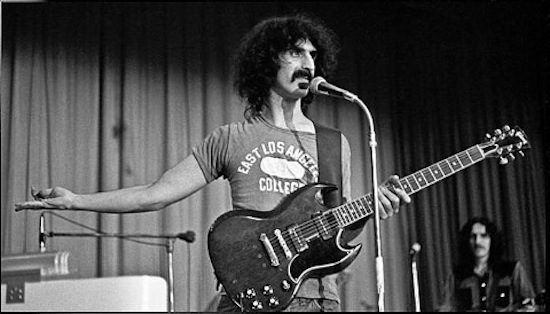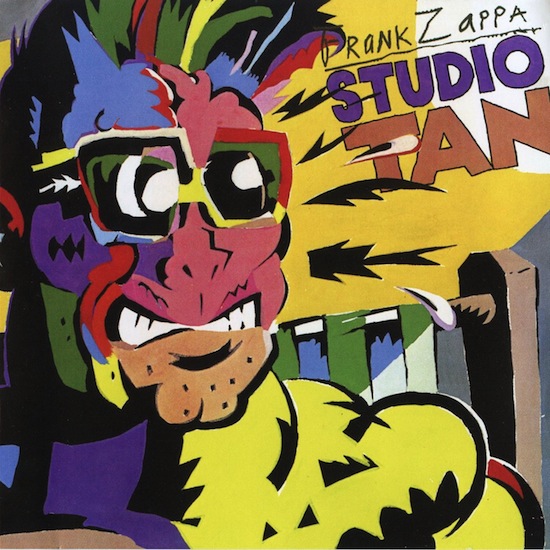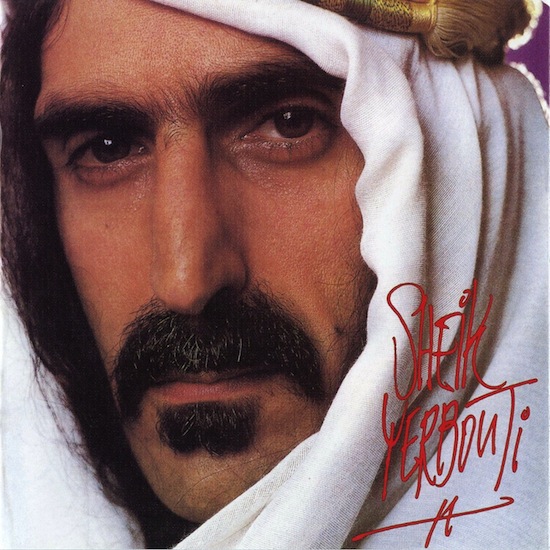As any Frank Zappa fan with over 20 years devotion behind them will tell you, there’s not much you can do to make someone like his music if they aren’t at least curious about it. It’s best discovered on your own terms, at your own pace. This isn’t so easy if you can’t actually buy it, which has been the case for a few years, until now. For the first time, Zappa’s albums are all finally available on iTunes as well as on new CD editions, an event more worthy of fanfare than the release of the Beatles’ catalogue, in this humble scribe’s opinion.
He made a huge amount of music – there can’t be many artists for whom a 60-album reissue program doesn’t include everything they’ve ever done. For all but the wealthiest of fans, however, this presents some difficulties – with CDs arriving at a wallet-crippling rate of 12 per month, this Zappa fix isn’t cheap. For the curious but uninitiated, this is a different sort of predicament as it’s pretty hard to figure out which route in to his material is best – there is just so much of it, and some of it will prove challenging for the casual listener. Zappa referred to this quality of his music as “statistical density” – or put another way “a maximum amount of aesthetic information in a minimum amount of time”. These reissues illustrate both points – they are hugely improved sonically, but there are a couple here that would be baffling if they were your first taste of his music. Nonetheless, that’s not to say there aren’t some great starting points – there definitely are.
Eschewing the loudness wars so common in reissues these days, the Zappa Family Trust are doing something much more interesting by returning to the original analogue mixes issued on vinyl. As previously noted on the Quietus, most of the Zappa CDs available during his lifetime had digital remixes, with digital reverb and in some egregious cases, overdubs added by musicians from his current band. Few admirers of 1967’s We’re Only In It For The Money can have been pleased to hear the implausibly named Chad Wackerman’s very 80s drum sound replacing Jimmy Carl Black. Many of the original CDs have not dated well, so it’s pleasing that nearly all of this second batch of reissues is based on the vinyl mixes.
The albums here cover three distinct phases of his career, from wheelchair-bound jazz-fusion, through the final incarnation of the Mothers of Invention, to a smaller, rockier line up under his own name. In December 1971 Zappa was thrown offstage by an audience member at a London gig, leaving him with such serious injuries that he spent the next few months in a wheelchair. In this period he produced two particularly jazz-influenced albums whilst honing his distaste for the UK. It saw him tour with two ensembles, The Grand Wazoo and the Petit Wazoo. Both line-ups were characterised by a weighty brass section, restrained guitar soloing and little or nothing in the way of vocals (perhaps a blessing after the Flo & Eddie era that preceded the injury).
Zappa tended to tour extensively, and recorded most of his concerts. His work frequently blurs the boundaries between studio and live albums, with studio overdubs on live material and songs on studio albums coming from a variety of live recordings spliced together. On-stage and tour bus humour often led to his most bizarre songs, whilst playing in front of an audience inspired superb performances. The fact that Zappa was convalescing during the recording of Waka/Jawaka and The Grand Wazoo is presumably a contributing factor in these two albums lacking the energy of others. They are impeccably arranged, with consistently strong playing from the excellent musicians, but when compared to what followed, they seem like less essential works for the more casual fan.
Waka/Jawaka, marked by the cover as the spiritual successor to Hot Rats, begins with the live favourite ‘Big Swifty’, which follows an oft-used template for Zappa. Opening and closing with a recognisable riff, the middle varied considerably in content and duration depending on the musicians available in his current band. This seventeen-minute studio version features electric piano from George Duke, extensive horn workouts and sinuous guitar before the riff emerges again, and is the standout here. A couple of shorter songs follow before the title track closes this short album in a similar style to the first, with a stunning brass arrangement. The reissue sounds wonderful, with a broad soundstage providing space for all the instruments to be heard.

A companion piece to Waka/Jawaka, The Grand Wazoo features a larger band and a narrative concept that ties it into the larger body of Zappa’s work. More tonally consistent than its predecessor, the original CD suffered from a rather thin sounding transfer. Here, the sound is expansive, particularly benefiting Aynsley Dunbar’s drums. As with Waka/Jawaka, the longer tracks are the best, as they give the band a chance to reveal their strengths.
By the time Over-Nite Sensation was released, Zappa had dumped the wheelchair and was back on his feet. The new band, the last to go by the name Mothers, was probably the best he ever had. They had so much personality, as is apparent from watching any of the live performances that were filmed. Tight, funky, and with virtuoso musicians throughout, they were fantastic. Their albums have a warm, spacious sound spread across the stereo image, and Zappa’s deep vocals sits at the front of the mix. His voice, newly lowered by a third following the injuries from his involuntary stage dive, is put to mischievous use with an array of songs that are more sexually themed than the social commentary of much of his sixties material.
Over-Nite Sensation is perhaps best known for ‘Dinah Moe-Humm’, one of Zappa’s most divisive tracks. It’s hard to believe that those fans that appreciated the snippets of Stravinsky and Bartok dropped into early Mothers Of Invention live performances would be equally entertained by lyrics such as “I whipped off her bloomers and stiffened my thumb, and applied rotation on her sugar plum”. Talking to someone who only knows Zappa for this song is like having to explain that there’s more to Bowie than ‘The Laughing Gnome’.
Zappa was apt at cultivating a variety of audiences. He claimed that the only way to get people to listen to music is to have singing, and that he might as well make it funny. Sometimes the people he mocked in lyrics seem to be the same type who made up a proportion of his fanbase. Although on one level some of his lyrics are undeniably puerile, it’s fruitless to be put off by this – there is so much more to appreciate than just the words. He often said that songs like ‘Dinah Moe-Humm’ made him enough money to be able to go out on loss-making tours and to pay for orchestras to try and perform some of his classical works. The music and production throughout Over-Nite Sensation is superb, with swaggering funk backing up the beautifully presented vocals, and it’s worth buying just for Montana, a track of infinite greatness. This new master has a lovely warm, slightly overdriven sound in comparison to previous versions, which suits the music perfectly. Zappa’s songs always sound best with a wide range of vocalists, as he had quite a limited range (he often joked that he wouldn’t have been able to pass the audition for his own band). Here the Mothers make great use of other singers, most notably Napoleon Murphy Brock, along with uncredited backup vocals from Tina Turner and The Ikettes and stridently bizarre contributions from Ricky Lancelotti.
Although Over-Nite Sensation marks the start of a great era, and sounds fantastic, some of the tracks can induce an ambivalent reaction. Apostrophe (‘) came from the same sessions, and is sonically very similar, but is a much better album. Here it’s crunchier than on old CDs, again sounding excellent. The two demonstrate Zappa’s sense of humour and doubtless brought him new fans at the cost of the approval of some critics. However, since he famously claimed that “most rock journalism is people who can’t write, interviewing people who can’t talk, for people who can’t read”, you can’t imagine he lost much sleep over it. The ‘Yellow Snow’ suite, which starts as a dream about being an Eskimo called Nanook, is simultaneously comical and complex, with frenetic percussion from the fabulous Ruth Underwood in ‘St Alphonzo’s Pancake Breakfast’ leading to a delirious Latin-tinged workout in ‘Father O’Blivion’. Whether you appreciate the humour of these albums or not, there’s no denying that Zappa appears to be having much more fun here than with the jazz-fusion stuff.
Roxy & Elsewhere is a live recording of this band that finds them in outstanding form. With two drummers, a percussionist, and Tom Fowler’s rattling bass butting up against George Duke’s Clavinet, the sound is tight and rhythmical, while Napoleon Murphy Brock and Duke have great back-and-forth vocal chemistry. Tracks like ‘Be-Bop Tango (Of The Old Jazzmen’s Church)’ are staggeringly complex, yet the band confidently tears through them while Zappa engages in his trademark audience participation. His guitar solos have a rich, liquid tone, heavily filtered through wah-wah, and there is a warmth here that some of his later playing lacked. This is pretty much a perfect album, the only disappointment being that it hasn’t been given the vinyl mix remastering treatment the others have.
A year later, One Size Fits All was released, another of his finest works. Ostensibly a studio album, the opener ‘Inca Roads’ was taken from a live TV special, with the guitar solo from another concert dubbed on. It’s a track that often produced Zappa’s best live solos and the one here is outstanding. The album contains humour without self-consciously striving to cause offence, and features some great songs. It’s worth the price of admission just for ‘Inca Roads’, the bass and drum interplay on ‘Andy’, and the bogus pomp of ‘Sofa No.1’ and ‘Sofa No.2’. ‘Po-Jama People’ is a dig at the musicians who came on the Wazoo tours, who apparently preferred to play chess rather than sleep with groupies. Perhaps this abstinence was a doomed attempt not to end up as the subject matter of his songs, as so many band members did. The new master sounds strikingly good as befits this seminal album, with all sorts of previously hidden flourishes emerging from the multitracks. The detail feels infinite, almost fractal – focus in on an instrument and all sorts of new complexities emerge. Beautifully recorded, One Size Fits All is an essential purchase.
The final outing for this group was Bongo Fury, which also featured new musicians such as Terry Bozzio, Zappa’s drummer for the next few years. His old friend Captain Beefheart also sang on several tracks. The album features live favourites such as ‘Advance Romance’, ‘Carolina Hard-Core Ecstasy’ and ‘Muffin Man’. It’s a very good album, and Beefheart’s harmonica brings to the foreground a bluesy feel hinted at on One Size Fits All, but compared to the previous three some of the band’s chemistry has gone. It’s better than Over-Nite Sensation, though, if less well recorded.
Zoot Allures features substantial lineup changes, as Zappa moved towards his next touring band. He played many of the instruments himself – guitar, bass, keyboards and vocals – and this might be why the album is more inert than the last few, lacking the funk of its predecessors. ‘Black Napkins’ and the title track were both signature pieces for him, and are outstanding, but many of the others are less memorable.
Zappa’s career famously featured several conflicts with record companies. In 1977 he delivered a 4 LP set called Läther to Warner Bros, which they promptly refused to issue while claiming he owed them four more albums. Zappa played the entire thing on the radio encouraging fans to tape it, and then split it into four separate albums, three of which are in this batch of reissues. The much-bootlegged full Läther got a posthumous 3CD release in 1996.
Zappa In New York, a live double album, was the first of these. Only Ruth Underwood survived from the Mothers, and the Saturday Night Live band lent five brass players. New vocalists, Patrick O’Hearn’s more processed bass tone and a refreshed rack of keyboards contributed to a pretty different-sounding group, a little less fuzzy but not necessarily worse for that. The band appears to be having fun and it’s another great set. Old Mothers tracks like ‘Cruising For Burgers’ and ‘Pound For A Brown’ feature alongside new material such as ‘The Illinois Enema Bandit’ and ‘The Black Page’, and there’s a good balance between more and less serious material. The version of ‘The Torture Never Stops’ is outstanding, as is Terry Bozzio’s drumming throughout. CD versions of this have always had a totally different mix to the vinyl, and also contain several extra tracks. Like Roxy, this is the same digital mix as the old CDs, which makes sense here, as the full version didn’t come out on analogue formats. To revert to the vinyl mix would have meant losing five and a half songs.
The next release was Studio Tan, which may well have the worst cover in the history of recorded music. Zappa had given Warner Brothers the tapes for this, Sleep Dirt and Orchestral Favourites, which they proceeded to put out without his permission, having commissioned cartoonist Gary Panter to make appalling sleeves (presumably more by accident than design). The first track, ‘The Adventures Of Greggery Peccary’, is one Zappa had been working on since his time in a wheelchair. It’s fair to say that within seconds most listeners are likely to be irritated beyond belief by the preposterous nature of the helium voices. Although it is an ambitious, complex and satirical piece that is musically rich, few are likely to be in a sufficiently patient mood to listen to the twenty-minute story of a small pig that works in “trendmongering”.

It’s hard to imagine anyone previewing ‘Greggery Peccary’ on iTunes then downloading it, but other tracks are easier to digest. ‘Revised Music For Guitar And Low Budget Orchestra’ had surfaced earlier on Jean-Luc Ponty’s album of Zappa tracks, King Kong, with violin instead of guitar, and is much improved over that incarnation. ‘RDNZL’ is fabulous, and another live vehicle for great guitar and piano solos. A great job has been done with the remastering on this CD, making it well worth upgrading if you have an earlier copy. Alternatively, just buy the two good tracks on iTunes for 99p each.
When Zappa released Sleep Dirt on CD in 1991 he took the material back into the studio first. Three tracks were written to be part of a musical but no vocals had been recorded, so he asked Thana Harris to sing on them, and also replaced some drum tracks. This new version is the first CD to revert to the pre-Thana vinyl version of the album, a considerable improvement.
Neither of these last two albums are as enjoyable as the material is on Läther. Somehow the music works much better as part of a larger whole. Zappa In New York is well worth owning, however, even if you have Läther, and it would serve as a great introduction to his music.
The final album in this batch is Sheik Yerbouti, one of Zappa’s most successful and the first on Zappa Records. Another double, another set of live recordings with plentiful overdubs, a number of his better-known songs debut here – ‘Bobby Brown’, ‘City Of Tiny Lites’ and ‘Dancin’ Fool’.
From the moment the lush vocals begin on ‘I Have Been In You’, it’s obvious that this is a beautifully recorded album. Zappa is on fine satirical form, with pretty much every track an attack on somebody or other. By the time the first four songs are over Peter Frampton, Bob Dylan, the broken hearted, mechanics, plumbers, unions and punk bands have all been skewered. It also features a well-known example of what he called xenochrony in ‘Rubber Shirt’, where drums from one performance are mixed with bass from another, despite the original tracks being in different time signatures and tempos. Sheik Yerbouti is another must-have album, which ends in an epic fashion with ‘Yo Mama’.
This may be the most improved of the whole batch. Fans have consistently complained about the previous Sheik CDs (with the exception of a rare EMI edition from 1986). The reissue is just stunning, with all sorts of parts that may have gone unnoticed before, and different edits of ‘I’m So Cute’ and ‘Wild Love’.
Most of this second phase of releases are worth forking out the cash for. There’s about 10 hours of music here, and while some of it is probably only of interest to more dedicated fans, some of his most accessible and enjoyable material can be found here too. This was a golden period for Zappa’s music with far more charm than some of his eighties stuff and few of the digital remix problems still found in a handful of the sixties reissues. Of the 12 CDs, the newly remastered 10 are all essential upgrades for completists. Since the spines are numbered, the fetishistic will doubtless need the whole set to avoid gaps on their shelves. The curious are advised to get New York, at least two of Apostrophe (‘), Roxy & Elsewhere and One Size Fits All, and maybe Sheik Yerbouti. You may disagree with these words, but don’t let that deter your curiosity to actually listen to the tunes. After all, as Zappa said, writing about music is like dancing about architecture.


